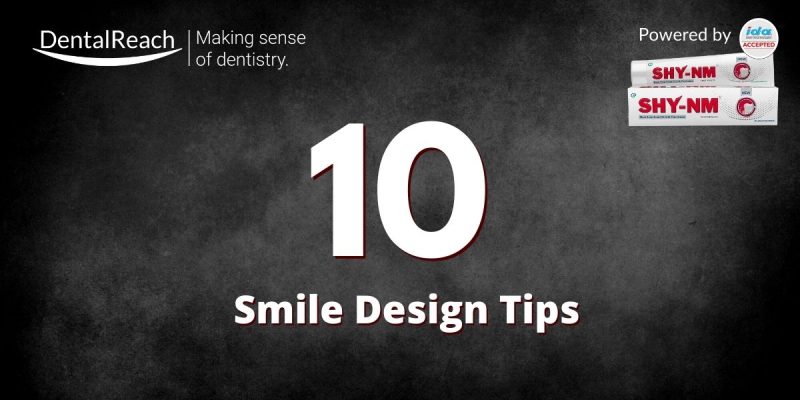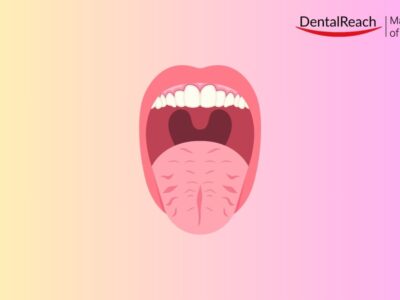“A smile is the shortest distance between two people.” – Unknown
When people, are unable to smile, even when they want to, simply because they are ashamed of doing so, it causes a whole host of social issues, especially with regards to relationships with people. The lack of a smile very quickly becomes the cause for increasing the distance between two individuals, often due to misunderstandings. As such the worth of a simple smile, is largely underestimated.

As dentists, we are uniquely suited to help people overcome issues with their smile professionally. But it isn’t that easy to design a smile i.e., where both we, the clinician as well as the patient are satisfied with the final outcome. To help circumvent that, I will be sharing ten tips, on how best to handle such cases, in this article.
1) Strike a balance between what YOU want and what the patient wants.
Many of us find ourselves rubbing our hands in glee, when confronted with a complex case. We start imagining the end result, replete with high end, fabulous metal free indirects, and the fantastic before and after images on our social media, while we sit grinning like a Cheshire cat at all the praises pouring in! Nothing wrong with this of course, but sometimes, our wild imagination needs to be tempered with a dose of reality. What we want may or may not be what the patient wants!
As a clinician, what we want is often ideal treatment (treating everything we see wrong with the best of materials) and what the patient wants is compromised treatment (constraints of budget, time, finances etc). If we want to be successful in clinical practice, we must learn to strike a healthy balance between the two.
2) Analyse the case thoroughly.
Not every smile design case is suited for minimally invasive veneers. At the same time, treating every case with crowns may not be the right solution. What I do is, make a list of all the treatment the patient requires, with respect to their chief complaint, and then achieve the maximum corrections possible, with minimum intervention. Sometimes this may necessitate 1-2 crowns and that’s okay, because true minimally invasive dentistry, is achieving the maximum with minimum, and sometimes a whole gamut of functional issues can be addressed with just 1-2 crowns. (Fig 1)

3) CAD CAM dentistry gives better results.
CAD CAM dentistry has revolutionized the dental field. And it’s not necessary that you as the clinician have to own your own intra oral scanner, to get started with it. It can be done the old-fashioned way by sending impressions /casts to the lab, which is then scanned, instead of the patient’s mouth. The lab then generates an Exocad link, for the clinician, which I personally analyse in minute detail. Especially with regards to various aspects such as proclination correction, correction of rotation, diastema closure, the curve of Spee as well as the functional occlusion.
I tweak this CAD several times, with the help of my technician, and I don’t proceed further until I’m satisfied. The best way to utilize the CAD is to print PMMA temps, which we can check on the patient. This makes a lot of difference in a clinician who’s starting out with his / her first smile design case. It helps patients visualise their final end result and gives the clinician a great confidence boost. This step is especially important because CAD crowns once milled, cannot incorporate major changes. The precise fit of CAD crowns is what they are revered for. But this can very well be a double-edged sword if we are not careful. (Fig 2)

4) Esthetics without function has no value.
This is an often-neglected aspect of smile design cases. Yes, esthetics is important but in the absence of function, it has no value. We must understand the mammoth role that anterior guidance plays in such cases. Failure to understand this, may well lead to wrong decision-making chair side, which will in turn lead to failure of the prosthesis. The clinician must have a very thorough understanding of steep versus shallow anterior guidance and which type of prosthesis is best suited where. And certain cases will require slight compromises in esthetics to achieve functional occlusion. When and where we compromise and by how much, is the key. (Fig 3)

5) Document your cases.
I cannot stress enough on the importance of this. A lot of clinicians think that documentation is terribly time consuming, and it’s meant only for celebrity dentists on social media. And that’s not true at all. Yes, documentation can be time consuming in the beginning, when you are not sure how to go about it, but just like everything else, there’s a learning curve involved. Once mastered, it requires only an extra minute or two, chair side, for every step. And its not necessary that one has to invest in an expensive DSLR camera for this purpose. Mobile Dental Photography also works.
When we document our high-ticket cases-
- it helps us to go back and check up on things, we might have missed out on initially.
- It’s a must to convey the correct shade to the technician, for an accurate match.
- Most importantly, it gives us a record of how we sent the patient at conclusion versus how the patient comes back to us. This is very important to settle disputes because, how we conclude the case depends on us, but how and when the patient returns, is entirely dependant on them. (fFig 4)

6) Shade Gradation.
The chiclet white smile may be what the patient requests of us, but we have a duty to steering the patient towards a more natural smile. One that does not appear fake. A successful smile design is one, where close friends and family know that there is something different but cannot put their finger to it.
Natural smiles have a shade gradation i.e., there is an increase in chroma progressively from the centrals to the canines. When we smile, all attention usually falls on the central incisors first and so it stands to reason that these teeth have the least chroma and the most value, thus appearing the brightest. This brightness or value decreases progressively from the centrals to the canines, with the canines having the most chroma and the least value. (Fig 5)

7) Check for phonetics.
This is another often neglected aspect of smile design cases. A lot of attention is given to the esthetics, so much so, that the phonetics, often takes a back seat. And this can prove to be quite detrimental. When changing the labio-lingual proclination or the inciso-gingival crown length of anterior teeth, one must pay special attention to the phonetics, especially the F, V and S sounds. Failure to do this may result in the patient being unable to enunciate certain words clearly, leading to clinical failure.
8) Use the right materials.
Using the right material every step of the way is important if we want to achieve clinical success. It’s not enough if we simply use elastomeric impression materials. Our choice of impression material must be based on the type of margin we have given in our preps. Is it subgingival? Or is it equigingival? Subgingival finish lines will demand retraction prior to impression. In addition, low viscosity impression material like light body will have to be syringed around the margins. This is technique sensitive, tedious and more time consuming. I personally avoid subgingival margins, unless there is a clear indication to do so, such as short clinical crown height or subgingival caries. I prefer equigingival margins for almost all my cases and use medium body impression material or monophase. This results in a significant ease in workflow.
Similarly, the patients pre-existing bite and habits, determine our choice of material for the final prosthesis. For e.g., is the patient a bruxer? Does the patient tend to incise? Lithium Di Silicate coping is a no-no in these situations and zirconia would be a better option, with or without Lithium Di Silicate layering.
Our choice of prosthesis material, dictates what we use to cement or bond our prosthesis. Lithium Di Silicate can be truly bonded to enamel, but there are newer materials, some specifically marketed to improve adhesion between zirconia and the tooth (bond containing 10-MDP, or adhesive resin cement such as G-Cem which has its own primer). Using the right materials can save us a lot of headache and embarrassment chairside.
9) Don’t forget pink esthetics!
We often have patients with missing anterior teeth, who have also undergone significant loss of both hard and soft tissue. As such, if we give them crowns which are entirely tooth coloured, it will look extremely unnatural. In order to improve the smile window, we must analyse the zenith of the existing soft tissue. The zenith of central incisors and canines are usually at the same level, while those of lateral incisors are lower (in case of upper) or higher (in case of lower). By analysing the zenith, we know exactly how much pink porcelain to add and where, so as to give our patients a smile window that has the pink and the white, balanced. Replacing that which is missing is fundamental in prosthetic cases, and pink porcelain is a great way to mask the missing soft and hard tissue. (Fig 6)

10) Check the smile window.
The smile window for most patients is premolar to premolar, while certain patients may have a molar to molar smile. And its very important to check this smile window, right at the beginning, before formulating and executing a treatment plan, in smile design cases. Imagine a smile design case, restored only from canine to canine, when the patient has a premolar-premolar smile, and the premolars are completely misaligned, spoiling the esthetic harmony.
Another thing to check for is the lip length. Patients with a short lip length tend to have a very “gummy” smile, while those with a longer lip length, tend to have a smile where the teeth are barely visible. The simple solution is crown lengthening in the former and lengthening of the incisal edge in the latter, but they have their own limitations. Excessive incisal length lengthening can interfere in phonetics as well as make the anteriors disproportionately large as compared to the face and the rest of the posteriors. A similar disproportion in size could occur with crown lengthening too. In some cases, the lip line is so high, that despite doing the maximum crown lengthening possible in that case, the smile window is still too gummy. Such cases cannot be treated with dentistry alone and will require lip repositioning. But most patients are very happy with the outcome that esthetic dentistry alone provides, for it’s a far cry from what they originally had.
Conclusion
Clinical success in smile design cases is not easy to achieve. There are so many parameters and all of them are equally important and are interconnected. Often failure at one, results in failure at another, leading to a cascading domino effect. For e.g., failure to use the right material for the right prep, leads to ill-fitting crowns, which not only affect the esthetics, but may also affect the functional occlusion. Hope these tips, help you navigate, the maze that are smile designs, with just a little bit of ease!




















Comments